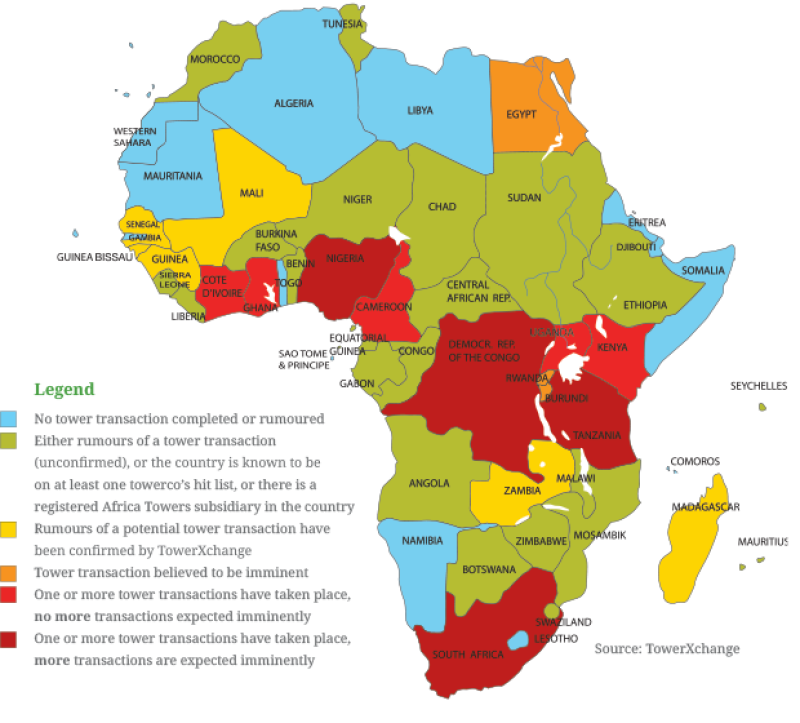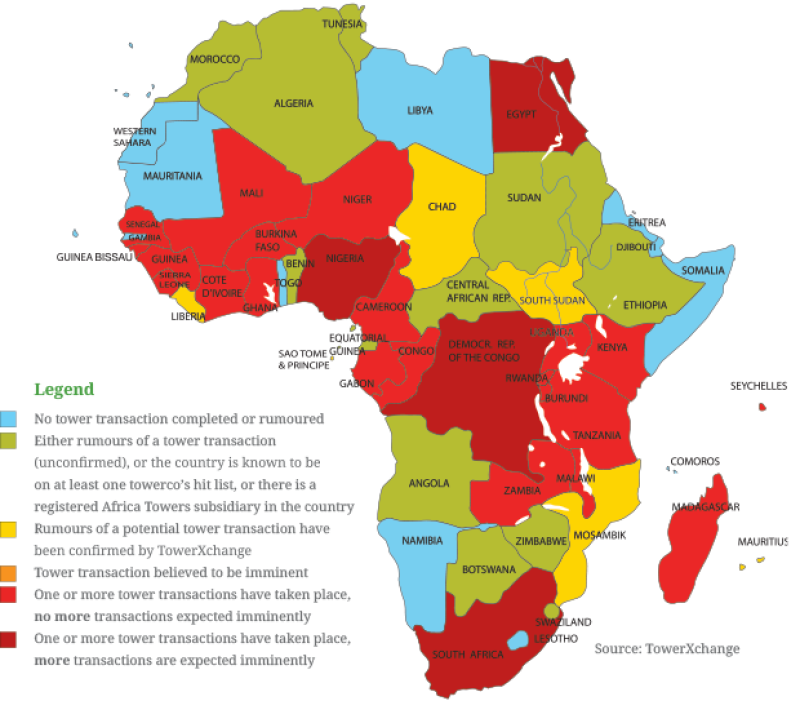TowerXchange forecasts that independent towercos will own or manage and market 30% of Africa’s towers by the end of 2014
As African telecom markets liberalise and mature, towers cease to be a source of competitive differentiation. There is a valuation incentive for operators first to market to sell their towers.
Towercos worldwide have been proved more efficient at managing towers than telecom operators. The capital markets recognise this, rewarding the split between passive infrastructure and the retail risk of customer-facing telecoms by increasing valuations of separated entities.
So as the independent towerco business model becomes more proven in Africa, more towers come to market, more capital is raised by towercos, and the pace of transactions accelerates. We think the future of the African tower industry is all about the transfer of towers from operator-captive to independent towercos - it’s a question of when, not if, in the majority of African markets.
So in this edition I thought I’d share a sneak preview of my opening address at the TowerXchange Meetup - our vision of the future of African towers. This analysis comes with the usual TowerXchange caveats - this forecast is our “best guess”. We’re qualitative not quantitative market researchers - we spend hours every day talking to key stakeholders in emerging market towers, but we respect the confidentiality of tower transactions, so we can only forecast in which markets we think tower transactions may take place, we can’t tell you which operator’s towers will come to market.
The current state of the African tower industry - the “proof of concept” phase
Regular TowerXchange readers will recognise the graphic below from issue 4 of the TowerXchange Journal: this is our view of the current state of the African tower industry. Click here for our detailed commentary on the current state of the African tower industry.
Updates since issue four:
Announcement of a second transaction in Tanzania (Vodacom selling 1,149 towers to Helios Towers Africa)
A small deal potentially imminent in Burundi (see the FTS interview here)
Hints at potential deals in the medium-term in Mauritius and Chad (see the news section)
TowerXchange’s tower count suggests there are currently 22-23,000 towers owned or managed and marketed by independent towercos in Africa. The total number of towers in Africa is tough to quantify, but for the purpose of this analysis we’ll use an estimate of 150,000, which would mean towercos own or manage and market approximately 15% of Africa’s towers.
TowerXchange tower transaction heatmap - current state

How this map could look by the end of 2014 - the “acceleration” phase

TowerXchange forecasts ten further tower transactions (either full sale and leaseback or supped-up managed services deals with BTS programmes) in Africa before the end of 2014. In addition, we expect the maturation of Airtel’s formative Africa Towers strategy, bringing to market an estimated 18,000 towers across their 17 countries.
I will present a detailed breakdown of this forecast at the TowerXchange Meetup, but it is summarised with our graphic on the next page showing of how we expect the TowerXchange tower transaction heat map to look by the end of 2014.
TowerXchange expects the number of towers owned, or at least managed and marketed, by independent towercos to increase by more than 30,000 by the end of 2014. Such a volume of transactions which will test the capital raising and management resources of Africa’s ‘Big Four’ towercos to the limit. As a result, we expect at least one more international towerco to enter the African market during the coming year.
Assuming the total number of towers in Africa increases to 175,000, towercos would own or manage and market over 30% of Africa’s towers by the end of 2014.
2015-16: the “scale and consolidation phase”
When will the African towercos run out of capital? Africa’s PE-backed towercos are going to need to substantially refinance if they are to have the digestive capacity to absorb all the towers coming to market, particularly if highly attractive, large portfolios in Nigeria become available. IHS announced their impressive raising of US$1bn of capital to date, but a sizable transaction in Nigeria could cost that much alone, never mind the additional capex to upgrade structures and power solutions.
American Tower are currently in a category of one with the strength of their balance sheet, and TowerXchange forecasts ATC will close several transactions in Africa in the next 18-24 months. But American Tower has appetite for only so much country risk, and Africa has to compete for ATC’s investments with opportunities in their domestic market as well as in the Americas and Europe.
If African towercos scale to portfolios of 10,000+ towers, and if they continue to trade in line with their acquisition economics, then institutional investors and infrastructure funds may enter the market and we may see a phase of consolidation starting in 2015-16.
Trying to forecast how the heatmap might look two to three years from now would be a futile endeavor - there are too many variables. Consolidation among operators could change the landscape dramatically. Towercos ability to raise the necessary capital is subject to the prevailing economic conditions. There seems to be a pool of investors who are comfortable investing in the American and European tower industry, and another pool comfortable investing in Africa, and relatively few investors at the intersection - as a community, we need to evangelise the African tower industry and attract more investors to the market.
More expertise is needed - there are only so many “tower people” and only so many people with proven African telecoms management experience and again the intersection of the two groups is a shallow pool that needs to deepen if the acceleration in growth of the tower industry is to proceed along the lines we have forecast.
When TowerXchange started our research 18 months ago, we spoke to a lot of senior decision makers at operators who were skeptical of the value proposition of selling their towers to independent towercos. But today every one of Africa’s tier one MNOs has structured deals with towercos or are seeking to do so. The African tower industry has reached “launch velocity” - it has an unstoppable momentum - and I hope you’ve enjoyed reading our view of how far the African tower industry can progress in the coming years.
Kieron Osmotherly will present TowerXchange’s detailed forecast for the next 2-3 years of the African tower industry at the TowerXchange Meetup on October 1 and 2. For details, click here
Having trouble viewing the Heatmaps? Download Issue 5 of TowerXchange FREE here - it’s much easier to read as a PDF!

